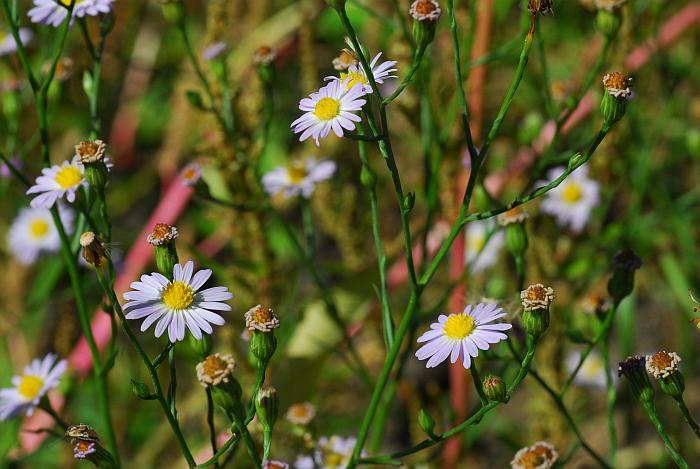Symphyotrichum subulatum (Michx.) G.L. Nesom
Inland Saltmarsh Aster

Introduced
CC = *
CW = -5
MOC = 11
© SRTurner
Symphyotrichum subulatum (Michx.) G.L. NesomInland Saltmarsh Aster | |
 |
Introduced CC = * CW = -5 MOC = 11 |
© SRTurner |
|
Family - Asteraceae/Astereae Habit - Taprooted annual forb.
Stems - Ascending, to 0.8 m, usually with numerous ascending branches, glabrous or nearly so.
Leaves - Basal and lower stem leaves usually absent at flowering, sessile or with a short, indistinct petiole, this sometimes slightly sheathing the stem, the blade 3-12 cm long, 0.3-1.0 cm wide, linear, sharply pointed, the margins entire, the surfaces often with a bluish cast, glabrous, the secondary veins and veinlets faint. Median and upper stem leaves progressively smaller, sessile, the base not clasping or sheathing the stem, the blades 0.8-7.0 cm long, linear, otherwise similar to the lower stem leaves.
Inflorescences - Panicles with relatively long, ascending to spreading branches, occasionally reduced to a solitary terminal raceme, the heads appearing short- or long-stalked, the bracts along the ultimate branches 0.3-0.8 cm long, sometimes relatively few, leaflike, mostly linear, noticeably shorter than the adjacent foliage leaves.
Heads - Heads mostly 1.0-1.7 cm in diameter. Involucre 5-8 mm long, the bracts in 3 or 4 unequal, overlapping series. Involucral bracts linear, sharply pointed, the tip erect or ascending, the slender midvein broadened gradually usually just above the base into a narrowly elliptic green tip with relatively broad, white or purplish-tinged margins, glabrous.
Florets - Ray florets 15-35 in 1 or 2 series, the corollas 4-9 mm long (often inrolling from tip quickly after collection), relatively slender, white to lavender. Disc florets 18-35, the corollas 3-4 mm long, the slender portion of the tube shorter than the very slightly expanded apical portion, the lobes 10-20 percent of the total length of the expanded portion. Pappus bristles 4-5 mm long, slightly longer than the florets, white to light straw-colored.
Fruits - 2.0-2.5 mm long, with 4-6 sometimes inconspicuous, longitudinal ribs, gray to light tan, moderately to densely hairy.
Flowering - September - January. Habitat - Pond margins, sloughs, swamps, crop field margins, lawns, roadsides. Origin - Native to the U.S. Lookalikes - Other small, white asters. Other info. - Although this plant is native to portions of the U.S., its presence in Missouri is probably due to artificial dissemination along highway corridors. Its natural range in the U.S. is largely a narrow strip all along the southern and eastern coastal regions. Its tolerance to saline soils, which are an element of its native residence in brackish areas, also confer a competitive advantage along highways which receive wintertime applications of salt. In Missouri the plant also seems to favor floodplain areas of major rivers. The plant also tolerates mowing, though this transforms the growth habit from upright with ascending branches to a low, clumping form. Photographs taken near Earth City, St. Louis County, MO, 9-28-2017, and near Creve Coeur Park, St. Louis County, MO, 10-24-2021 (SRTurner). |